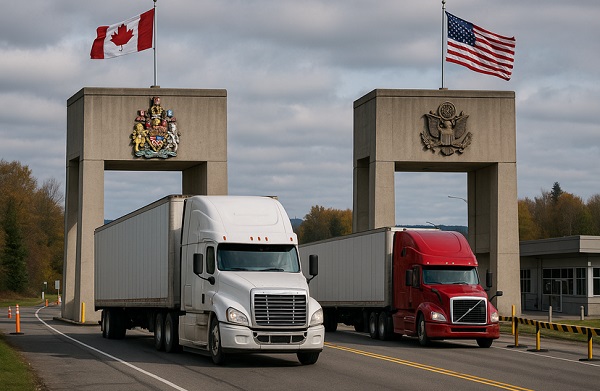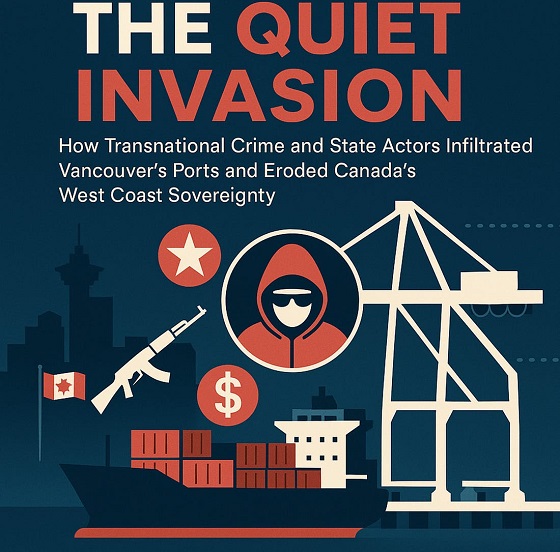Business
Tariffs Get The Blame But It’s Non-Tariff Barriers That Kill Free Trade

From the Frontier Centre for Public Policy
By Ian Madsen
From telecom ownership limits to convoluted regulations, these hidden obstacles drive up prices, choke innovation, and shield domestic industries from global competition. Canada ranks among the worst offenders. If Ottawa is serious about free trade, it’s time to tackle the red tape, not just the tariffs.
Governments claim to support free trade, but use hidden rules to shut out foreign competition
Tariffs levied by governments on imports are a well-known impediment to trade. They raise costs for consumers and businesses alike. But tariffs are no longer the main obstacle to the elusive goal of “free and fair trade.” A more significant—and often overlooked—threat comes from non-tariff barriers: the behind-the-scenes rules, subsidies and restrictions that quietly block competition from foreign exporters.
These barriers can take many forms, including import licences, quotas, discriminatory regulations and state subsidies. The result is often higher prices, limited product choices and reduced innovation, since foreign competitors are effectively shut out of the market before they can enter.
This hidden protectionism harms both consumers and Canadian firms that rely on imported goods or global supply chains.
To understand the global scope of these barriers, a recent analysis by the Tholos Foundation sheds light on their prevalence and impact. Its 2023 Non-Tariff Barriers Index Report examined the policies, laws and trade practices of 88 countries, representing 96 per cent of the world’s population and GDP.
The results are surprising: the United States, with some of the lowest official tariffs, ranked 65th on non-tariff barriers. Canada, by contrast, ranked fourth.
These barriers are often formalized and tracked under the term “non-tariff measures” by international organizations such as the United Nations Conference on Trade and Development (UNCTAD) and the World Trade Organization.
UNCTAD notes that while some serve legitimate non-trade objectives like public health or environmental protection, they still raise trade costs through procedural hurdles that can disproportionately affect small exporters or developing nations.
Other barriers include embargoes, import deposits, subsidies to favoured companies, state procurement preferences, technical standards designed to exclude foreign goods, restrictions on foreign investment, discriminatory taxes and forced technology transfers.
Many of these are detailed in a study by the Leibniz Institute for Economic Research at the University of Munich.
Sanctions and politically motivated trade restrictions also fall under this umbrella, complicating efforts to build reliable global trade networks.
Among the most opaque forms of trade distortion is currency manipulation. Countries like Japan have historically used ultra-low interest rates to stimulate growth, which also weakens their currencies.
Others may unintentionally devalue their currency through excessive, debt-financed spending. Regardless of motive, the effect is often the same: foreign goods become more expensive, and domestic exports become artificially competitive.
Canada is no stranger to non-tariff barriers. Labelling laws, technical standards and foreign ownership restrictions, particularly in telecommunications and digital media, are clear examples. Longstanding rules prevent foreign companies from owning Canadian telecom providers, limiting competition in an industry where Canadians already pay among the highest cellphone bills in the world. Similar restrictions on investment in broadcasting and interactive digital media also curtail innovation and investment.
Other nations use these barriers just as liberally. The U.S. has expanded its use of the “national security” exemption to justify restrictions in nearly any industry it sees as threatened. The European Union employs a wide range of non-tariff measures that affect sectors from agriculture to digital services. So while China is frequently criticized for abusing trade rules, it is far from the only offender.
If governments are serious about pursuing freer, fairer global trade, they must confront these less visible but more potent barriers. Tariffs may be declining, but protectionism is alive and well, just hidden behind layers of red tape.
For Canada to remain competitive and protect consumers, we must look beyond tariffs and scrutinize the subtler ways the federal government is restricting trade.
Ian Madsen is a senior policy analyst at the Frontier Centre for Public Policy.
Alberta
Pierre Poilievre – Per Capita, Hardisty, Alberta Is the Most Important Little Town In Canada

From Pierre Poilievre
Business
Why it’s time to repeal the oil tanker ban on B.C.’s north coast

The Port of Prince Rupert on the north coast of British Columbia. Photo courtesy Prince Rupert Port Authority
From the Canadian Energy Centre
By Will Gibson
Moratorium does little to improve marine safety while sending the wrong message to energy investors
In 2019, Martha Hall Findlay, then-CEO of the Canada West Foundation, penned a strongly worded op-ed in the Globe and Mail calling the federal ban of oil tankers on B.C.’s northern coast “un-Canadian.”
Six years later, her opinion hasn’t changed.
“It was bad legislation and the government should get rid of it,” said Hall Findlay, now director of the University of Calgary’s School of Public Policy.
The moratorium, known as Bill C-48, banned vessels carrying more than 12,500 tonnes of oil from accessing northern B.C. ports.
Targeting products from one sector in one area does little to achieve the goal of overall improved marine transport safety, she said.
“There are risks associated with any kind of transportation with any goods, and not all of them are with oil tankers. All that singling out one part of one coast did was prevent more oil and gas from being produced that could be shipped off that coast,” she said.
Hall Findlay is a former Liberal MP who served as Suncor Energy’s chief sustainability officer before taking on her role at the University of Calgary.
She sees an opportunity to remove the tanker moratorium in light of changing attitudes about resource development across Canada and a new federal government that has publicly committed to delivering nation-building energy projects.
“There’s a greater recognition in large portions of the public across the country, not just Alberta and Saskatchewan, that Canada is too dependent on the United States as the only customer for our energy products,” she said.
“There are better alternatives to C-48, such as setting aside what are called Particularly Sensitive Sea Areas, which have been established in areas such as the Great Barrier Reef and the Galapagos Islands.”
The Business Council of British Columbia, which represents more than 200 companies, post-secondary institutions and industry associations, echoes Hall Findlay’s call for the tanker ban to be repealed.
“Comparable shipments face no such restrictions on the East Coast,” said Denise Mullen, the council’s director of environment, sustainability and Indigenous relations.
“This unfair treatment reinforces Canada’s over-reliance on the U.S. market, where Canadian oil is sold at a discount, by restricting access to Asia-Pacific markets.
“This results in billions in lost government revenues and reduced private investment at a time when our economy can least afford it.”
The ban on tanker traffic specifically in northern B.C. doesn’t make sense given Canada already has strong marine safety regulations in place, Mullen said.
Notably, completion of the Trans Mountain Pipeline expansion in 2024 also doubled marine spill response capacity on Canada’s West Coast. A $170 million investment added new equipment, personnel and response bases in the Salish Sea.
“The [C-48] moratorium adds little real protection while sending a damaging message to global investors,” she said.
“This undermines the confidence needed for long-term investment in critical trade-enabling infrastructure.”
Indigenous Resource Network executive director John Desjarlais senses there’s an openness to revisiting the issue for Indigenous communities.
“Sentiment has changed and evolved in the past six years,” he said.
“There are still concerns and trust that needs to be built. But there’s also a recognition that in addition to environmental impacts, [there are] consequences of not doing it in terms of an economic impact as well as the cascading socio-economic impacts.”
The ban effectively killed the proposed $16-billion Eagle Spirit project, an Indigenous-led pipeline that would have shipped oil from northern Alberta to a tidewater export terminal at Prince Rupert, B.C.
“When you have Indigenous participants who want to advance these projects, the moratorium needs to be revisited,” Desjarlais said.
He notes that in the six years since the tanker ban went into effect, there are growing partnerships between B.C. First Nations and the energy industry, including the Haisla Nation’s Cedar LNG project and the Nisga’a Nation’s Ksi Lisims LNG project.
This has deepened the trust that projects can mitigate risks while providing economic reconciliation and benefits to communities, Dejarlais said.
“Industry has come leaps and bounds in terms of working with First Nations,” he said.
“They are treating the rights of the communities they work with appropriately in terms of project risk and returns.”
Hall Findlay is cautiously optimistic that the tanker ban will be replaced by more appropriate legislation.
“I’m hoping that we see the revival of a federal government that brings pragmatism to governing the country,” she said.
“Repealing C-48 would be a sign of that happening.”
-

 Business1 day ago
Business1 day agoRFK Jr. says Hep B vaccine is linked to 1,135% higher autism rate
-

 Crime2 days ago
Crime2 days agoNational Health Care Fraud Takedown Results in 324 Defendants Charged in Connection with Over $14.6 Billion in Alleged Fraud
-

 Censorship Industrial Complex1 day ago
Censorship Industrial Complex1 day agoGlobal media alliance colluded with foreign nations to crush free speech in America: House report
-

 Health2 days ago
Health2 days agoRFK Jr. Unloads Disturbing Vaccine Secrets on Tucker—And Surprises Everyone on Trump
-

 Business10 hours ago
Business10 hours agoWhy it’s time to repeal the oil tanker ban on B.C.’s north coast
-

 Alberta5 hours ago
Alberta5 hours agoAlberta Provincial Police – New chief of Independent Agency Police Service
-

 Alberta10 hours ago
Alberta10 hours agoPierre Poilievre – Per Capita, Hardisty, Alberta Is the Most Important Little Town In Canada
-

 Business1 day ago
Business1 day agoElon Musk slams Trump’s ‘Big Beautiful Bill,’ calls for new political party

